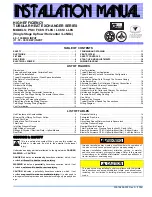
then starts dropping exponentially. When this
grid drops below cutoff again, the circuit has
completed one cycle of its approximately 50-
cycle waveform.
With the circuit configuration just described,
the horizontal sweep can be triggered with re
petitive signals, over a wide range of frequen
cies, without readjustment. When not receiving
triggers, the sweep continues at approximately
a 50-cycle rate. Thus, in the absence of any trig
gering signal the sweep generates a base line
which indicates that the instrument is adjusted
to display any signal that might be connected
to the vertical deflection system.
TIME-BASE GENERATOR
The Time-Base Trigger produces a negative
going rectangular waveform which is coupled to
the Time-Base Generator circuit. This waveform
is differentiated in the grid circuit of V135A to
produce sharp negative-going triggering pulses
to trigger the Time-Base Generator in the proper
time sequence. As mentioned previously, posi
tive-going pulses are also produced in the dif
ferentiation process, but these are not used in the
operation of the circuit.
The Time-Base Generator consists of three
main circuits: A bistable sweep-gating multivi
brator, a Miller runup circuit, and a hold-off cir
cuit. The Sweep-Gating Multi circuit consists of
V135A, V145A and the cathode-follower V135B.
The essential components in the Miller runup
circuit are the Miller Runup Tube V I61 A, the
Runup C.F. V I61B, the On-Off Diodes V I52, the
Timing Capacitor Cl 60 and the Timing Resistor
R160. The hold-off circuit consists of the Hold-
O ff C.F’s V183A and V145B, the Hold-Off ca
pacitor Cl 80 and the Hold-Off Resistors R181
and R180, A or B (shown on the Timing Switch
diagram).
In the quiescent state V135A is conducting and
its plate voltage is down. This cuts off V145A
through the cathode-follower V135B, the voltage
divider R141-R143 and the cathode resistor R144.
The quiescent stage of the Miller Runup Tube
is determined by a dc network between plate
and grid. This network consists of the neon lamp
B167, the grid-cathode impedance of the Runup
C.F., and the On-Off Diodes. The purpose of this
dc network is to establish a voltage at the plate
of the Miller Runup Tube of such a value that
the tube will operate above the knee, and thus
over the linear region, of its characteristic curve.
In the quiescent state the grid of the Miller
Tube rests at about —2 volts. There is about a
1-volt drop in the On-Off Diodes, about 25-volts
bias on the Runup C.F., and about a 60-volt drop
across the neon lamp. This-establishes a quies
cent voltage of about -f-32 volts at the plate of
the Miller Tube.
A negative trigger pulse, arriving at the grid
of V135A, will then cause the Sweep-Gating
Multi to switch rapidly to its other state. That is,
V135A will be cutoff and V145A will start to
conduct. As V145A conducts its plate voltage,
and the voltage at the plates of the On-Off
Diodes, goes down. This cuts off the diodes,
which permits the grid of the Miller tube and the
cathode of the Runup C.F. to seek their own volt
ages.
The grid of the Miller Tube starts negative,
since it is connected to the —150-volt supply
through the Timing Resistor. The plate of the
Miller Tube then starts positive, carrying with it
the grid and cathode of the Runup C.F. This
raises the voltage at the top of the Timing Ca
pacitor, which in turn raises the voltage at the
grid of the Miller Tube and prevents the grid
from going negative. The gain of the Miller
Tube is about 200; this means that a 150-volt
change in the plate voltage will maintain the
grid voltage constant, within three-quarters of a
volt, through the plate-to-grid feedback network.
The Timing Capacitor Cl 60 starts charging
with current from the —150-volt supply. Since
the voltage at the grid of the Miller Tube re
mains essentially constant, the voltage drop
across the Timing Resistor and hence the charg
ing current through it remains essentially con
stant. Hence, Cl 60 charges linearly and the volt
age at the cathode of the Runup C.F. rises line
arly. Any departure from a linear rise in the
voltage at this point will produce a change in
the voltage at the grid of the Miller Tube in such
a direction as to correct for the error.
The linear rise in voltage at the cathode of
the Runup C.F. V I61B is used as the sweep time
base. Timing Capacitor C l60 and Timing Resis
tor R160 are selected by means of the TIME/CM
switch SW160. The Timing Resistor determines
the current that charges the Timing Capacitor.
By means of the Timing Switch, both the size of
the capacitor being charged and the current
4-6
CIRCUIT DESCRIPTION — TYPE 502
Summary of Contents for 502 series
Page 2: ......
Page 6: ......
Page 7: ...Fig 1 1 Type 502 Oscilloscope with accessories ...
Page 8: ......
Page 36: ......
Page 50: ......
Page 77: ...0 0 TYPE 502 OSCILLOSCOPE A BLOCK DIAGRAM ...
Page 79: ...INPUT A M PLIFIE R SECOND D R IV E R O UTPUT A M PLIFIE R C F S AM PLIFIE R X 10 X 100 ...
Page 82: ...V722 type 502 o s c illo s c o p e HEATER WIRING DIAGRAM A POWER SUPPLY ...
Page 90: ...M ILLE RRUNUP CIRCU IT 350 V 2 3 M ILUSEC TIME BASE GENERATOR 12 8 58 ...
Page 94: ...CALIBRATOR MULTIVIBRATOR TYPE 502 OSCILLOSCOPE A ...
















































